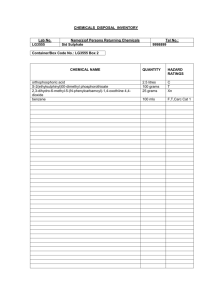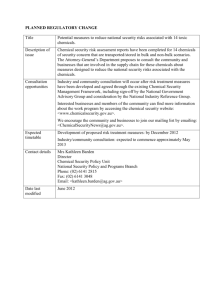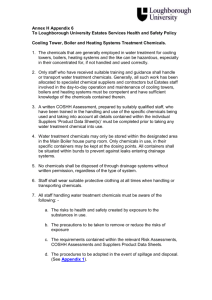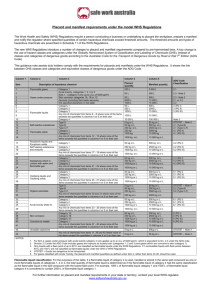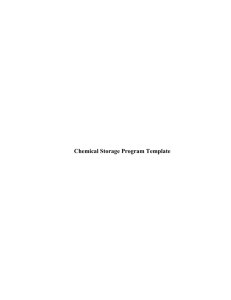Lab chemicals storage
advertisement
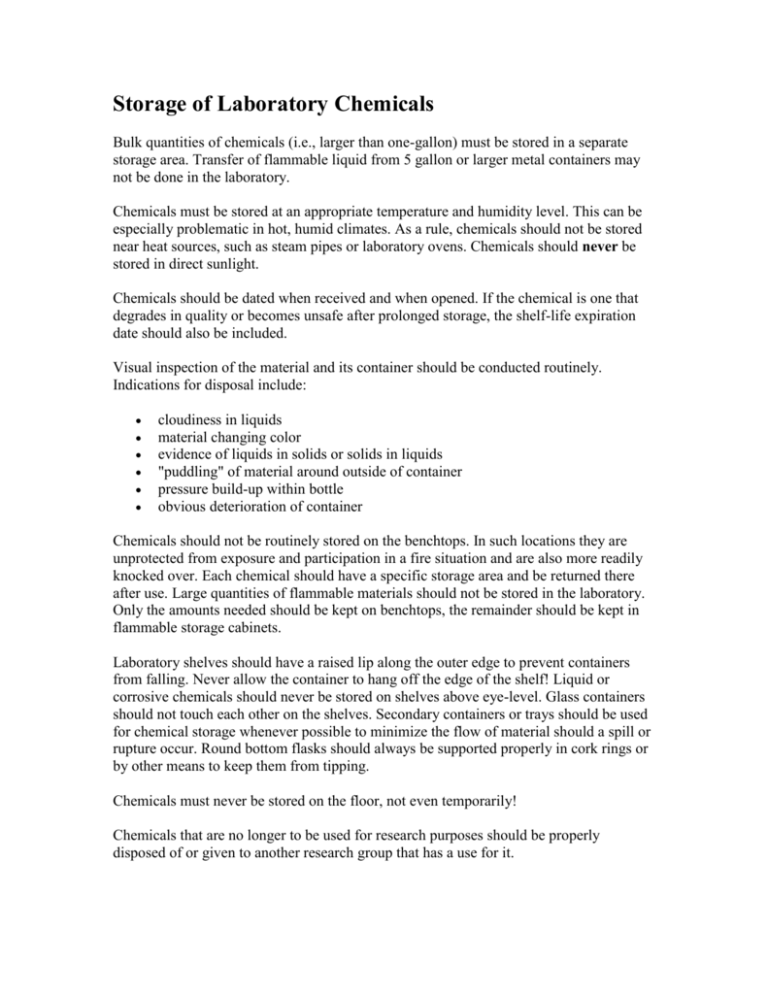
Storage of Laboratory Chemicals Bulk quantities of chemicals (i.e., larger than one-gallon) must be stored in a separate storage area. Transfer of flammable liquid from 5 gallon or larger metal containers may not be done in the laboratory. Chemicals must be stored at an appropriate temperature and humidity level. This can be especially problematic in hot, humid climates. As a rule, chemicals should not be stored near heat sources, such as steam pipes or laboratory ovens. Chemicals should never be stored in direct sunlight. Chemicals should be dated when received and when opened. If the chemical is one that degrades in quality or becomes unsafe after prolonged storage, the shelf-life expiration date should also be included. Visual inspection of the material and its container should be conducted routinely. Indications for disposal include: cloudiness in liquids material changing color evidence of liquids in solids or solids in liquids "puddling" of material around outside of container pressure build-up within bottle obvious deterioration of container Chemicals should not be routinely stored on the benchtops. In such locations they are unprotected from exposure and participation in a fire situation and are also more readily knocked over. Each chemical should have a specific storage area and be returned there after use. Large quantities of flammable materials should not be stored in the laboratory. Only the amounts needed should be kept on benchtops, the remainder should be kept in flammable storage cabinets. Laboratory shelves should have a raised lip along the outer edge to prevent containers from falling. Never allow the container to hang off the edge of the shelf! Liquid or corrosive chemicals should never be stored on shelves above eye-level. Glass containers should not touch each other on the shelves. Secondary containers or trays should be used for chemical storage whenever possible to minimize the flow of material should a spill or rupture occur. Round bottom flasks should always be supported properly in cork rings or by other means to keep them from tipping. Chemicals must never be stored on the floor, not even temporarily! Chemicals that are no longer to be used for research purposes should be properly disposed of or given to another research group that has a use for it. Flammable materials must never be stored in domestic-type refrigerators. Only explosion-proof or flammable material refrigerators should be used for storage of these chemicals within a laboratory environment. All containers stored within the refrigerator should be tightly capped to keep vapors from interacting with each other and to alleviate "smell" problems. Flasks with cork, rubber or glass stoppers should be avoided because of the potential for leaking. All containers stored in the refrigerator must be properly labeled. Inventory the materials in your refrigerator frequently to avoid overcrowding with materials that have long since been forgotten. Also make it a point to defrost your refrigerator occasionally so that chemicals do not become trapped in unique ice formations! Before flammable materials are stored in a refrigerator, it should be determined if keeping the material chilled will serve any purpose. No benefit is derived from refrigerating a chemical that has a flash point below the temperature of the refrigerator. Never store peroxide formers (i.e., ether) in a refrigerator! Fume hoods should not be used as general storage areas for chemicals. This may seriously impair the ventilating capacity of the hood. Gas cylinders must be securely strapped to a permanent structure (wall, lab bench, etc.). When they are not in use they should be capped off. On termination, graduation or transfer of any laboratory personnel, all hazardous materials must be properly disposed of, or arrangements made to transfer them to the laboratory supervisor. Below are examples of chemical groups that can be used to categorize storage. Use these groups as examples when separating chemicals for compatibility. Acids Make sure that all acids are stored by compatibility (ex. separate inorganics from organics). Store concentrated acids on lower shelves in chemical-resistant trays or in a corrosives cabinet. Separate acids from incompatible materials such as bases, active metals (ex. sodium, magnesium, potassium) and from chemicals which can generate toxic gases when combined (ex. sodium cyanide and iron sulfide). Bases Store bases away from acids. Store concentrated bases on lower shelves in chemical-resistant trays or in a corrosives cabinet. This will temporarily contain spills or leaks and protect shelving from residue. Flammables Approved flammable storage cabinets should be used for flammable liquid storage. You may store 20 gallons of flammable liquids per 100 sq.ft. in a properly fire separated lab. The maximum allowable quantity for flammable liquid storage in any size lab is not to exceed 120 gallons. You may store up to 10 gallons of flammable liquids outside of approved flammable storage cabinets. An additional 25 gallons may be stored outside of an approved storage cabinet if it is stored in approved safety cans not to exceed 2 gallons in size. Use only explosion-proof or intrinsically safe refrigerators and freezers for storing flammable liquids. Peroxide-Forming Chemicals Peroxide-forming chemicals should be stored in airtight containers in a dark, cool, and dry place. Unstable chemicals such as peroxide-formers must always be labeled with date received, date opened, and disposal/expiration date. Segregate from oxidizers and acids. Peroxide-forming chemicals should be properly disposed of before the date of expected peroxide formation (typically 6-12 months after opening). Water-Reactive Chemicals Store in a cool, dry place, away from any water source. Make certain that a Class D fire extinguisher is available in case of fire. Oxidizers Make sure that all oxidizers are stored by compatibility. Store oxidizers away from flammables, combustibles, and reducing agents. Toxic compounds should be stored according to the nature of the chemical, with appropriate security employed when necessary. Toxins Light-Sensitive Chemicals Store in amber bottles in a cool, dry, dark place.

